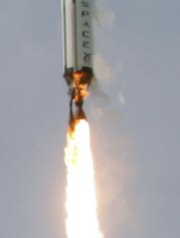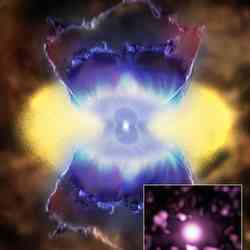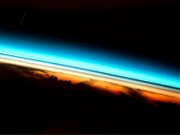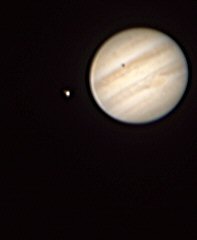|
SpaceTides e-zine
#40- 27 March 2006
Internet
Newsletter of ASSA Bloemfontein Centre,
South Africa, to the public
www.assabfn.co.za/spacetide
|
In this issue of SpaceTides
|
INDEX
1. Spaceflight news from around the
world
2. Astronomy news from around the world
3. Interesting space facts
4. Space questions
5. Sky Observation log
6. Amateur Astronomers' Corner
7. Astronomy & Science in Southern Africa
8. Astronomy events in the City of Bloemfontein
9. Web links
10. Advertisements (Scope-X on 6 May 2006 in Johannesburg)
|
Dear
SpaceTides subscribers
The
rain and clouds (though very welcome!) in South Africa's interior
don't allow much night sky observations at the moment, but we have
some drier months ahead, which is also a fine time for deep sky
objects and constellations. Especially in April and May observers
in the southern hemisphere have the spectacular Carina/Vela/Puppis
area of the sky at their disposal.
Private space enterprise suffered a major setback recently when
the SpaceX "Falcon 1" rocket, carrying a weather satellite,
failed during launch. Governmental space programs, although they
have huge budgets, can be very lethargic and ineffective. In many
enthusiasts' opinion, private space enterprise is the way of future
space transport - they are not as restricted as government programs
when it comes to taking risks and seems to be quite open for new
ideas and innovation.
Have you ever thought of the value of astronomical teaching for
children? Keep in mind that astronomy tends to broaden a child's
perspective very much. It makes them come in contact with the splendour
and mysteries of nature and teaches them an appreciation for the
natural environment from an early age.
Enjou the
issue!
Gerrit
Penning
Editor
Total subscribers as at 27 March 2006: 427 (+19 from
previous issue #39)
|
|
1. Spaceflight news from around the world
|
|

|
Falcon
1's maiden rocket launch unsuccessful
SpaceX, founded by Elon Musk (born and schooled in South Africa),
suffered a setback when their Falcon 1 rocket failed during its
maiden launch.
The rocket burned up shortly after lift-off and fell in the Pacific
ocean. Although all vehicle systems performed without error, a fuel
leak of yet unknown origin caused a fire which shut of the rocket's
main engine.
Elon Musk made his fortune as co-founder of PayPal and from the
earlier Zip2 software application. He formed SpaceX with the purpose
of immensely reducing the cost of rocket launches to Earth's orbit
and beyond. The Falcon 1 rocket is three times less expensive than
rockets of similar power. Larger Falcons are planned for the future.
Extracts from: http://www.spaceflightnow.com/falcon/f1/060324failure.html
SpaceX website: http://www.spacex.com/
Left: Falcon 1 on fire during launch. Credit: SpaceX
|
|
2. Astronomy news from around the world
|
|

An illustration showing quasar activity in the centre of a galaxy.
Galactic superwinds are expelling gas away from the galaxy's centre
at tremendous speeds. Credit: NASA.
|
A
Quasar in the Distance...
Many
galaxies appear to have black holes at their centres. Sometimes
these black holes become very active by sucking up large quantities
of materials (like gas) and emitting huge amounts of energy in the
X-ray spectrum. Supermassive black holes gone berserk. And quasars
result...
What is a "quasar"? A quasar is a source of electromagnetic
energy so immense that one quasar can dwarf the energy output of
all the stars in its galaxy. An overheating engine in space!
Quasars seem to be powered by the accretion of material (like gasses)
onto supermassive black holes in the centres of very distant galaxies.
As gasses "fall into" the black hole, it ignites and create
a "quasar" (energy source) of immense proportions.
Quasars are also referred to as luminous versions belonging to a
type of "active galaxies". Much research still needs
to be done on these interesting objects.
Researchers using the Chandra X-Ray satellite detected two such
quasars recently, during the ignition phase of the gasses falling
onto the black hole. Eventually the gasses will be blown away from
the centre of the galaxy by winds created during explosions and
"things will turn back to normal", as the black hole doesn't
have enough food for further meals...
Read article at: http://www.universetoday.com/am/publish/4C37_43_quasar.html?2332006
More on what quasars are: http://en.wikipedia.org/wiki/Quasar
|
|
3. Interesting Space Facts
|
|
- Earth's atmosphere consists of 21% oxygen and 78%
nitrogen. The remaining 1% consists of other gasses.
- Once your car indicate that it has travelled 380 000 km
in its life, you have travelled the total distance between the
Earth and the Moon!
- The fastest spacecraft built by man reached speeds of 252,800
km/h - the NASA-German Helios 1 & 2 - during their orbits of
the Sun (source).
This translates to about 70.2 km per second. Compare this speed
to the speed of light which is 300,000 km per second!
- Nine of the top 10 warmest years globally have occurred
since 1995. Various studies indicate that the high average temperatures
in the northern hemisphere over the last decade are unprecedented
over the past 2,000 years.
From: http://www.ucsusa.org/global_warming/science/heat-wave-2005-and-Global-Warming.html
|
|

Space debris (Delta
2 rocket parts) that fell in South Africa in 2000, 3 objects spaced
over 100 km. Photo from the NASA Orbital Debris Program Office website.
Watch your head!
|
How
many man-made satellites are in orbit around Earth?
Only
about 400 to 500 active satellites are currently orbiting Earth.
An exact figure may be difficult to ascertain, especially if you
include spy satellites! Many hundreds of inactive (dead) satellites
still orbit the Earth.
The real problem lies with space debris: useless man-made objects
orbiting Earth. According to the NASA Orbital Debris Program Office
website there are approximately 11,000 objects larger than 10 cm.
The number of objects between 1 and 10 cm in diameter is estimated
to be greater than 100,000. The number of particles smaller than
1 cm may exceed tens of millions.
Pieces of space debris pose a risk to satellites as they can travel
at 28 000 km/h. If they hit another object, major damaged can be
caused.
More information:
http://www.orbitaldebris.jsc.nasa.gov/faqs.html#3
General info:
Windows
to the Universe Space Debris update
|
|

Shuttle
photo of Earth's atmosphere from Space. Credit: NASA/JSC.
|
What formed the oxygen in the Earth's
atmosphere?
The
so-called "Biological Era" of Earth's natural history
was marked by a reduction in the carbon dioxide in the atmosphere
and an increase in oxygen - the latter being the most important
gas for life on Earth. (Simplified) - hundreds of millions of years
ago, small one celled plant-like organisms in the sea, protected
by the water from the dangerous radiation of the Sun, started undergoing
photosynthesis - the process whereby solar energy is used by plants
to produce certain organic molecules and oxygen. A protective
ozone layer (a form of oxygen) formed in the initial phases followed
by "ordinary" oxygen in the atmosphere. Primitive life
in the sea thus generated the oxygen in the atmosphere, paving the
way for life on land.
More info at: http://vortex.plymouth.edu/atmosphere/evolve.html
|
|
Will
the Earth be destroyed and all life exterminated on 1 April 2006
by a huge purple asteroid resembling the figure of a well known
dinosaur still alive today?
No. Probably not. Most unlikely.
|
|
|
Descriptions for end-March 2006 around 20h00 from
South Africa.
The naked eye planets
Mercury: In the constellation of Aquarius in the morning
Venus: In Capricornus in the morning - very bright
Earth: Somewhere between the orbits of Venus and Mars
Mars: In the constellation of Taurus, visible from sunset until
about 22h00 when it sets
Jupiter: Currently in Libra in the evenings, rising 20h15
Saturn: Currently in Cancer to the north, visible throughout the
evening from sunset
Constellations
and stars
The old constellation of Argo Navis (Jason's ship) - now consisting
of Carina, Vela, Puppis and Pyxis are ideally located in
the evening sky for observations. They contain a wealth of deep
sky objects and bright stars. Now is the time - be sure to take
advantage.
Leo in the north is filling the evening sky with its bright
stars.
Hydra, Corvus and Crater are slowly taking
over the mid-sky above our heads.
Other
events
New moon on 29 March 2006. Full moon on 13 April 2006.
|
|
6. Amateur Astronomers' Corner
|
|

This image of
Jupiter, taken by Mauritz Geyser (ASSA Pretoria) in 2005
was stacked from 810 frames, using a QuickCam Pro 4000 webcam with
2x barlow lens through an 8 inch telescope. Even though poor sky
conditions existed, the shadow of the moon Europa is clearly visible
as well as the Great Red Spot (centre right).
|
Stacking
astro-photos to reduce image noise
Many
digital camera owners are well aware that digital images can contain
a lot of "noise" - stray pixels on the photo that weren't
meant to be there in the first place. Especially in darker photos
noise can accumulate to irritating levels. The chips of digital
cameras are quite sensitive to light. When you take photos of the
night sky, either with or without the aid of optical instruments,
stray light (from e.g. the city) can enter the camera and cause
unwanted pixels.
There's a solution for lowering noise on digital images. Most amateurs
are knowledgeable about the "image stacking" practice:
using a software application to "stack" numerous photos
taken in quick succession of one particular subject. Even photos
taken with an ordinary low-budget digital camera can be stacked.
Steadily point the camera (or webcam!) through the telescope (start
with a bright object like Jupiter or Saturn), take a few photos
one after the other as quickly as possible, transfer it to your
computer, pull them into the stacking application and let the program
work its magic.
According to "The
New Amateur Astronomer" by Martin Mobberley, noise on a
photo reduces with the square root of the number of images stacked:
in theory a stack of 4 planetary images will have half the noise
of a single image. 16 will have 4.
Stacking broadens your options when it comes to image processing.
You can now play around more comfortably with exposure times. How
many images to stack? That you will probably have to find out for
yourself, for your particular expertise and equipment as well as
your specific photographing conditions.
Image
stacking software can be found at:
Registax: http://registax.astronomy.net/
Astrostack: http://www.astrostack.com/
|
|
7. Astronomy & Science in Southern Africa
|
|
|
etaCarina
- (Astrophotography)
etaCarina, maintained by Maurtiz Geyser (ASSA Pretoria), is a website
specializing in astrophotography. Here you will find some of the
best photos taken by South African astrophotographers. It includes
numerous pictures of the planets, the moon, deep sky objects and
related items.
Go to: http://www.etacarina.co.za/
Image at left: The Milky Way in the area of the tail of Scorpius.
Credit: Mauritz Geyser.
|
For
other SA Astronomy websites, go to the SpaceTides SA Astronomy
Portal at:
www.assabfn.co.za/spacetides/sa_astronomy.htm
|
8. Astronomy Events in the City of Bloemfontein
|
The
different astronomy organisations in the City, working hand-in-hand
to inform people about the
interesting world of astronomy and spaceflight,
can be reached through the following details:
|
Boyden Observatory
One of the most publicly accessible
observatories of its kind on the continent, also housing SA's third
largest telescope. To arrange group visits to the Observatory,
phone Dr. Matie Hoffman at 051-401 2924 for more information, or
send an e-mail to him at: HoffmaMJ.SCI@mail.uovs.ac.za
|
|
The Friends of Boyden: www.assabfn.co.za/friendsofboyden
A
public interest group for Boyden Observatory and for people interested
in joining the astronomical community of Bloemfontein,
but not necessarily make astronomy their hobby. Contact Braam van
Zyl at 051-436 7555 (h) or visit the website above for more information
regarding the Friends. Anyone can become a member. R50 membership
fee per year for a whole family. Members receive the latest information
on astronomy events in Bloem, attend the Friends' presentations
free of charge and receive the "Naghemel" quarterly newsletter
compiled by ASSA Bloemfontein, by post.
April's
Friends meeting:
a special evening for the Friends of Boyden on the controversial
though very important subject of "Light Pollution" will
be presented at Boyden Observatory. Please phone Braam for more
information.
|
|
ASSA Bloemfontein
Centre: www.assabfn.co.za
Affiliated
with the Astronomical Society of Southern Africa, the Bloemfontein
Centre of ASSA is an active organisation of amateur astronomers
meeting on a regular basis to discuss and practice astronomy as
hobby. Activities include solar-, lunar-, deep sky- and comet &
meteor observations, as well as historical research, telescope building,
tours and away-weekends under dark skies. Send an e-mail to mail@assabfn.co.za
or visit the website.
|
Onthou ook om Boyden Sterrewag se gereelde sterrekunde
berigte in die "Ons Stad" plaaslike koerant te lees.
Dit bevat ook meer inligting rondom Boyden besoektye.
|
10. Advertisement - ScopeX 2006
|
|
ScopeX 2006 in Johannesburg
This year's ScopeX will be held on Saturday, 6 May 2006 at
the Military History Museum in Johannesburg. Each year's
ScopeX is a very enjoyable event and no-doubt a learning experience
for everyone attending. Amateur telescope makers show visitors their
telescopes, presentations by well-known amateur and professional
astronomers are given, astronomical merchandise is exhibited and
much more. A must for anyone interested in amateur astronomy and
especially telescope making. The world renowned photographic science-astronomer David Malin from Australia will
be the keynote speaker!
Please visit
http://www.assajhb.info/DNN/ for full
information and forward this advertisement to persons you think
will be interested.
|
|



